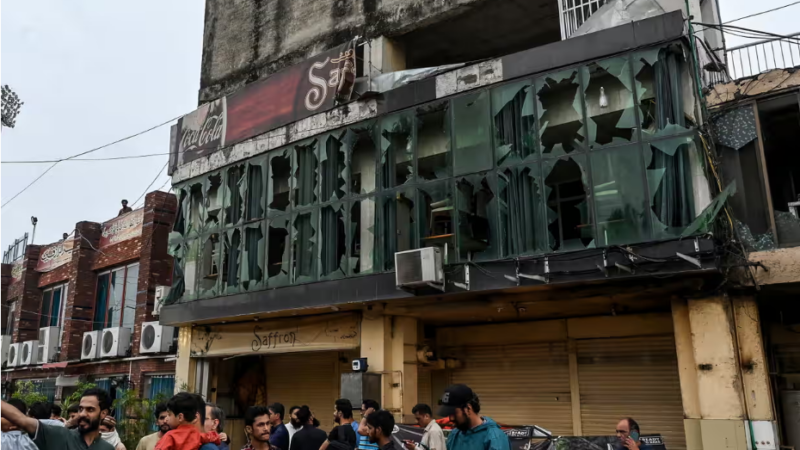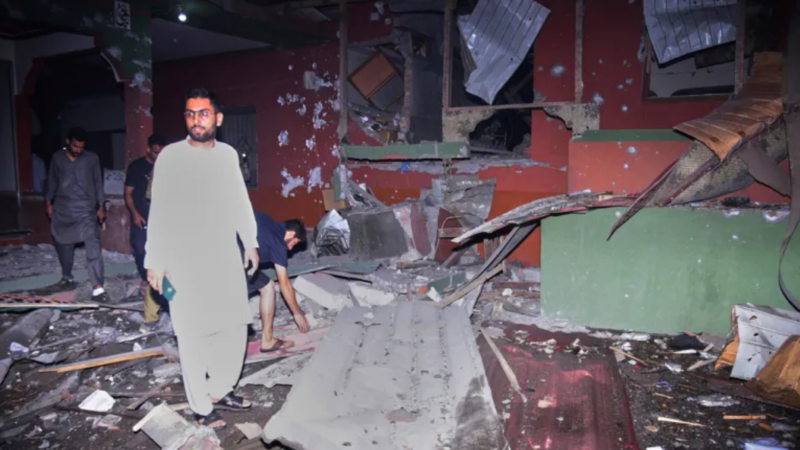The changing face of terrorism in the UK since 9/11

In the year of the 11 September 2001 attacks, the average terror suspect in Britain was a non-white, non-British man above the age of 30. Two decades later, he is likely to be white, British and far younger.
The statistics, which began to be collected following al-Qaeda’s attacks on the twin towers, tell the story of the changing face in terrorism in the UK, reflecting the shift from mainly from Northern Ireland-related terrorism to jihadi groups including Isis, and the recent rise of the far-right.
Dean Haydon, senior national coordinator for Counter Terrorism Policing, has witnessed the evolution first-hand. He became an officer in 1988, seeing IRA bombs go off outside an army recruitment centre in Wembley and at the Staples Corner interchange.
By the time of the July 2007 London bombings, he was part of the Metropolitan Police’s anti-terrorist branch – as it was then known – and has stayed mainly in the sector ever since.
Mr Haydon says the most recent changes have been the rise of the extreme right-wing and “self-initiated” terrorists who act alone. “The threat and profile of terrorists has completely changed,” he adds, going on to say: “We are dealing with individuals that are self-radicalised, that are looking at extremist materials online… they’re not waiting for some kind of direction or approval from above.”
Not only have terrorists become less trained, less prepared and less networked, they are also becoming younger, more British and more white. And the changing profile and tactics of terrorists mean stopping them is harder, Mr Haydon says.
In the year to September 2002, only three terror suspects under the age of 18 were arrested in Britain, whereas the number was 25 in the 12 months to this September.
Neo-Nazi terrorist groups like National Action, pictured in 2016, have targeted young members online (Bitchute)
Almost two-thirds of convicted terror offenders used to be aged 30 and over. Now it’s only a fifth.
The proportion of terror suspects who define themselves as British has jumped from less than a third to 80 per cent in the same period.
Racial demographics have also changed dramatically. From 2001 to 2004, most people arrested on suspicion of terror offences were white, but then suspects of Asian ethnicity overtook, making up the largest proportion until 2018.
But now the number of white people arrested on suspicion of terror has exceeded Asian people for the fourth consecutive year.
Around 13 per cent of cases being handled by counterterror police in Britain are from the extreme right, while the bulk remains jihadist.
But in the Prevent counterextremism scheme, which aims to stop people from being drawn into terrorism, most referrals are labelled as holding a “mixed-unstable or unclear ideology”.
“People consuming material online in the early days were pretty much stovepiped in relation to those groups, like al-Qaeda or the IRA, whereas now you see youngsters experimenting with all of it because there’s so much extremist material online from different organisations,” Mr Haydon says.
(Home Office)
“Part of that is to seek instructions on how to commit an attack or build a device; some of it is interest; some of is kids growing up; some of it sharing and disseminating for a bit of kudos – ‘look what I’ve found’ sort of thing – and some of it is being used to desensitise people.”
The increase in online terrorist propaganda has resulted in a rise in prosecutions for collecting or disseminating material that could be useful for attacks, which are now the most common terror charges in Britain.
In almost every year from 2007 to 2017, the most frequent charge was preparation of terrorist acts, including attack plots and travelling to fight abroad.
Mr Haydon says the internet had “changed terrorism completely”, by making more ideological and instruction material available, and allowing encrypted online contact rather than in-person networking.
Previously, people who wanted to join jihadi organisations mainly aspired to train or fight abroad.
Isis propaganda, pictured, spurred a wave of lone actor attacks (Dabiq)
He explains that groups like the IRA and al-Qaeda had hierarchical command structures, where “somebody at the top would approve and say ‘yes, I want you to do that attack in this place’”.
Complex plots such as 9/11 and 7/7 involved “an awful lot of planning” over months or years, involving senior figures assigning people to roles, and deploying them accordingly.
But the emergence of Isis in 2014 changed everything. The group, which evolved out of al-Qaeda in Iraq, originally called on supporters to travel to its new “caliphate”. As western nations started making that more difficult and bombing Isis territory, the group changed tack.
In a speech released on 21 September, an Isis spokesperson called on followers to “defend the Islamic State … from your place wherever you may be”.
They called for lone-wolf attacks on military, police and security targets, but also gave permission to kill any “disbelievers” in countries that had joined the US-led coalition against Isis.
Mr Haydon said the speech “changed the threat completely” in the UK, sparking a wave of homegrown terror plots from Isis supporters – including some who had been prevented from travelling to Syria.
Timeline of the Isis caliphate Show all 19 1 / 19 Timeline of the Isis caliphate Timeline of the Isis caliphate ISIS began as a group by the merging of extremist organisations ISI and al-Nusra in 2013. Following clashes, Syrian rebels captured the ISIS headquarters in Aleppo in January 2014 (pictured) AFP/Getty Timeline of the Isis caliphate Abu Bakr Al-Baghdadi declared the creation of a caliphate in Mosul on 27 June 2014 Timeline of the Isis caliphate Isis conquered the Kurdish towns of Sinjar and Zumar in August 2014, forcing thousands of civilians to flee their homes. Pictured are a group of Yazidi Kurds who have fled Rex Timeline of the Isis caliphate On September 2 2014 Isis released a video depicting the beheading of US journalist Steven Sotloff. On September 13 they released another video showing the execution of British aid worker David Haines Timeline of the Isis caliphate The US launched its first airstrikes against Isis in Syria on 23 September 2014. Here Lt Gen William C Mayville Jnr speaks about the bombing campaign in the wake of the first strikes Getty Timeline of the Isis caliphate Isis militants sit atop a hill planted with their flag in the Syrian town of Kobani on 6 October 2014. They had been advancing on Kobani since mid-September and by now was in control of the city’s entrance and exit points AFP/Getty Timeline of the Isis caliphate Residents of the border village of Alizar keep guard day and night as they wait in fear of mortar fire from Isis who have occupied the nearby city of Kobani Getty Timeline of the Isis caliphate Smoke rises following a US airstrike on Kobani, 28 October 2014 AFP/Getty Timeline of the Isis caliphate YPG fighters raise a flag as they reclaim Kobani on 26 January 2015 VOA Timeline of the Isis caliphate Isis seized the ancient Syrian city of Palmyra on 20 May 2015. This image show the city from above days after its capture by Isis Getty Timeline of the Isis caliphate Kurdish forces are stationed on a hill above the town of Sinjar as smoke rises following US airstrikes on 12 November 2015 AFP/Getty Timeline of the Isis caliphate Kurdish forces enter Sinjar after seizing it from Isis control on 13 November 2015 AFP/Getty Timeline of the Isis caliphate Iraqi government forces make the victory sign as they retake the city of Fallujah from ISIS on 26 June 2016 Getty Timeline of the Isis caliphate Iraqi forces battle with Isis for the city of Mosul on 30 June 2017 AFP/Getty Timeline of the Isis caliphate Members of the Iraqi federal police raise flags in Mosul on 8 July 2017. On the following day, Iraqi prime minister Haider Al Abadi declares victory over Isis in Mosul Getty Timeline of the Isis caliphate Members of Syrian Democratic Forces celebrate in Al-Naim square after taking back the city of Raqqa from Isis. US-backed Syrian forces declare victory over Isis in Raqqa on 20 October 2017 after a four-month long campaign Getty Timeline of the Isis caliphate Female fighters of the Syrian Democratic Forces celebrate in Al-Naim Square after taking back the city of Raqqa from Isis. US-backed Syrian forces declare victory over Isis in Raqqa on 20 October 2017 after a four-month long campaign AFP/Getty Timeline of the Isis caliphate Trucks full of women and children arrive from the last Isis-held areas in Deir ez-Zor, Syria in January 2019 They were among the last civilians to be living in the ISIS caliphate, by this time reduced to just two small villages in Syria’s Deir ez-Zor Richard Hall/The Independent Timeline of the Isis caliphate Zikia Ibrahim, 28, with her two-year-old son and 8-month-old daughter, after fleeing the Isis caliphate, on Saturday 26 January 2019 Richard Hall/The Independent
British self-initiated terrorists have since become the country’s greatest threat, with al-Qaeda and Isis popularising “martyrdom”, and Mr Haydon said attackers now mostly want to die in the act.
Several jihadi attackers have worn fake suicide vests to ensure they are shot dead by armed police, while far-right terrorist Darren Osborne told survivors of his van ramming in Finsbury Park: “I’ve done my job – you can kill me now.”
There has also been a shift in targeting, away from landmarks, government and military locations and infrastructure, to seemingly random public places like Streatham high street and a quiet Surrey suburb.
Mr Haydon says the changing terrorist profile and tactics in Britain has made attacks harder to detect and stop.
“The terrorism threat and the challenge that we all face trying to stop attacks has become ever more difficult,” he adds. “Our collective challenge is far more difficult than it has ever been.”






